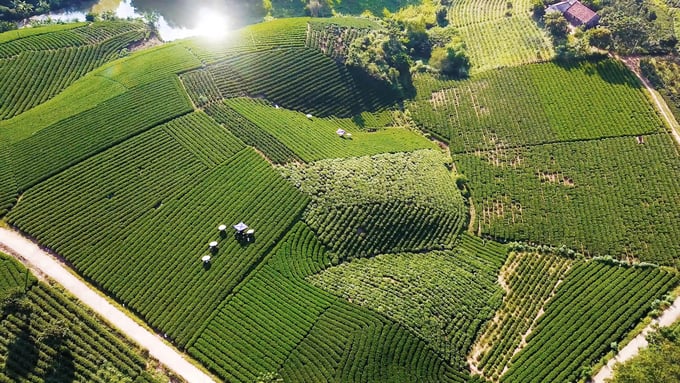November 26, 2025 | 07:19 GMT +7
November 26, 2025 | 07:19 GMT +7
Hotline: 0913.378.918
November 26, 2025 | 07:19 GMT +7
Hotline: 0913.378.918

With an output of 214,300 tons in 2022, Vietnam ranks 5th globally in tea production. Photo: HT.
According to FAO data, global tea production – including black, green, and instant teas – reached 6.7 million tons in 2022, with China’s production expansion fueling much of this growth.
China's tea output has been rising at an annual rate of 5.9%, from 1.92 million tons in 2013 to 3.34 million tons in 2022, propelled by increasing domestic demand and heightened health awareness among Chinese consumers. As the world's largest tea producer, China accounts for nearly 50% of global tea production, followed by India with a 20.5% share. India’s tea production grew from 1.35 million tons in 2021 to 1.37 million tons in 2022.
In 2022, Vietnam ranked fifth globally, producing 214,300 tons of tea. Vietnam is quickly establishing itself in both black and green tea production. Known for its light, balanced flavor, Vietnamese green tea is especially popular. Vietnam also boasts unique varieties like lotus tea and jasmine tea, where tea leaves are scented with flowers.
Tea consumption is shaped by multiple factors, including price, income, age, education, occupation, and cultural background. With a growing preference for healthy, natural beverages, demand for specialty and premium teas is soaring, opening up new opportunities in the global tea market.
Over the past decade, international tea prices, tracked by the FAO composite price index a weighted average of black teas, including crushed, torn, and curly (CTC) and Orthodox types, have remained stable.
The FAO composite tea price index rose by 14.5%, increasing from $2.44/kg in 2021 to $2.80/kg in 2022. This surge was driven by strong demand and tighter supplies from Sri Lanka. However, after peaking in 2022, tea prices fell by 9% in 2023 to $2.54/kg due to higher supply, lower demand, and a shortage of high-quality tea. Additionally, the global economic downturn has further pressured prices by reducing both domestic and international demand, resulting in a surplus in the tea market.
Other factors influencing international tea prices include market access, the potential impacts of pests and weather on production, changes in input costs, exchange rates, and shifts in market structure.
Factors contributing to the increase in tea consumption include rising per capita income in major tea-producing countries and growing awareness of the health benefits associated with tea.

Innovation and "premiumization" are key drivers for market expansion.Photo: HT.
In terms of exports, global black tea exports are expected to reach 1.81 million tonnes by 2032. Growth is anticipated across all major exporting countries, with Kenya leading the way with an average annual growth rate of 1.4%. India and Sri Lanka are also projected to see average increases of 1.1% and 0.7%, respectively. Over the next decade, India is expected to become the second-largest exporter of black tea, surpassing Sri Lanka.
Green tea exports are projected to reach 574,000 tonnes by 2032, largely driven by increased sales from China and Vietnam. China is expected to maintain its dominance in the export market, with exports reaching 429,919 tonnes, accounting for 75% of global green tea exports. Vietnam is anticipated to export 84,409 tonnes, followed by Japan with 14,320 tonnes and Indonesia with 6,244 tonnes.
Translated by Quynh Chi

(VAN) An Giang promotes supply-demand connections, standardizes quality and builds value chains, creating a foundation for sustainable bird’s nest development and aiming to expand exports.
/2025/11/24/5339-4-nongnghiep-075331.jpg)
(VAN) Recently, the conference on 'Sustainable Fisheries Linkage Chain - Tilapia for Export' took place in Tien Hai commune, Hung Yen province.
/2025/11/21/4309-2-153400_128.jpg)
(VAN) Green and low-emission rice is paving the way for Vietnamese rice to enter high-end markets, marking the beginning of a transformation journey toward greening and elevating the national rice brand.

(VAN) ‘Right to Win’ outlines a national action plan that shapes a new vision for Viet Nam’s agriculture in an era of renewal and global integration.

(VAN) Lam Dong’s farmed sturgeon output this year is expected to reach 2,300 tons, worth VND 450 billion, affirming the brand’s position on the market.

(VAN) A surge in Ukrainian egg exports, largely driven by soaring sales to the UK over the last few years, has notably pushed up egg prices on the domestic market.

(VAN) The price of Arabica Catimor coffee in Quang Tri is currently at VND 25,000–27,000/kg (fresh cherries), the highest level ever recorded